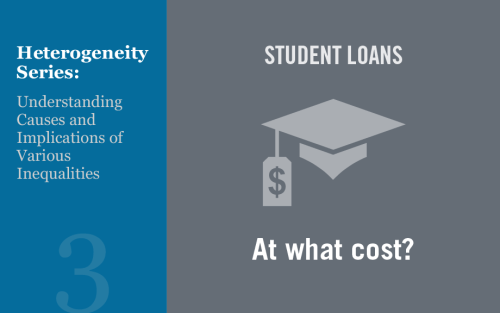Delinquency Is Increasingly in the Cards for Maxed‑Out Borrowers

This morning, the New York Fed’s Center for Microeconomic Data released the Quarterly Report on Household Debt and Credit for the first quarter of 2024. Household debt balances grew by $184 billion over the previous quarter, slightly less than the moderate growth seen in the fourth quarter of 2023. Housing debt balances grew by $206 billion. Auto loans saw a $9 billion increase, continuing their steady growth since the second quarter of 2020, while balances on other non-housing debts fell. Credit card balances fell by $14 billion, which is typical for the first quarter. However, an increasing number of borrowers are behind on credit card payments. In this post, we explore the relationship between credit card delinquency and changes in credit card “utilization rates.”
FHA First‑Time Buyer Homeownership Sustainability: An Update

An important part of the mission of the Federal Housing Administration (FHA) is to provide affordable mortgages that both promote the transition from renting to owning and create “sustainable” homeownership. The FHA has never defined what it means by sustainability. However, we developed a scorecard in 2018 that tracks the long-term outcomes of FHA first-time buyers (FTBs) and update it again in this post. The data show that from 2011 to 2016 roughly
21.8 percent of FHA FTBs failed to sustain their homeownership.
Car Prices Drive Up Borrowing

Total household debt increased substantially during the second year of the COVID-19 pandemic, with a $1.02 trillion increase in aggregate debt balances, according to the Quarterly Report on Household Debt and Credit for the fourth quarter of 2021 from the New York Fed’s Center for Microeconomic Data. The yearly increase was the largest seen since 2007 in nominal terms and was boosted by particularly robust growth in mortgage balances, which grew by nearly $900 billion through 2021. Credit card balances, which have followed an unusual path during the pandemic, saw a large seasonal increase in the fourth quarter but remain well below pre-pandemic levels. And student loan balances increased only modestly through 2021 due to lower enrollment and also due to administrative forbearance on federal student loans—the smallest annual increase we’ve seen since 2004. Outstanding auto loan balances grew in 2021 by $84 billion. The $734 billion in newly opened auto loans through the year was the largest volume we’ve seen in our data.
Just Released: Racial Disparities in Student Loan Outcomes

A $20 billion rise in student loan balances in the third quarter of this year contributed to a $92 billion increase in total household debt, according to the latest Quarterly Report on Household Debt and Credit from the New York Fed’s Center for Microeconomic Data. This post explores racial disparities in student loan outcomes using information about the borrowers’ locations, grouping zip codes based upon which racial group constitutes the majority of an area’s residents.
Who Borrows for College—and Who Repays?

Student loans are increasingly a focus of discourse among politicians, policymakers, and the news media, resulting in a range of new ideas to address the swelling aggregate debt. Evaluating student loan policy proposals requires understanding the challenges faced by student borrowers. In this post, we explore the substantial variation in the experiences of borrowers and consider the distributional effects of various policy options.
Just Released: Mind the Gap in Delinquency Rates

Total household debt balances increased by $192 billion in the second quarter of 2019, boosted primarily by a $162 billion gain in mortgage installment balances, according to the latest Quarterly Report on Household Debt and Credit from the New York Fed’s Center for Microeconomic Data (the mortgage installment balances exclude home equity lines of credit, which are reported separately and have been declining in balance for some time). The new mortgage total of $9.4 trillion is slightly higher than the previous high in mortgage balances from the third quarter of 2008 in nominal terms.
Just Released: Shifts in Credit Market Participation over Two Decades
Just Released: Auto Loans in High Gear

Total household debt increased modestly, by $32 billion, in the fourth quarter of 2018, according to the latest Quarterly Report on Household Debt and Credit from the New York Fed’s Center for Microeconomic Data. Although household debt balances have been rising since mid-2013, their sluggish growth in the fourth quarter was mainly due to a flattening in the growth of mortgage balances. Auto loans, which have been climbing at a steady clip since 2011, increased by $9 billion, boosted by historically strong levels of newly originated loans. In fact, 2018 marked the highest level in the nineteen-year history of the loan origination data, with $584 billion in new auto loans and leases appearing on credit reports, up in nominal terms from 2017’s $569 billion. In this post, we take a closer look at the composition and performance of outstanding auto loan debt using the New York Fed’s Consumer Credit Panel (CCP), which is based on anonymized Equifax credit data and also the source for the Quarterly Report.
Just Released: A Look at Borrowing, Repayment, and Bankruptcy Rates by Age

Household debt balances increased in the third quarter of 2018, a 17th consecutive increase. Total debt balances reached $13.51 trillion, a level more than 20 percent above the trough reached in 2013, according to the latest Quarterly Report on Household Debt and Credit from the New York Fed’s Center for Microeconomic Data. With today’s report we begin publishing a new set of charts that depict debt and repayment outcomes by the age of the borrower. The report and this analysis are based on the New York Fed Consumer Credit Panel (CCP), a 5 percent sample of anonymized Equifax credit reports. Here we’ll highlight three of the new charts.
Just Released: Great Recession’s Impact Lingers in Hardest‑Hit Regions

The New York Fed’s Center for Microeconomic Data today released our Quarterly Report on Household Debt and Credit for the fourth quarter of 2017. Along with this report, we have posted an update of state-level data on balances and delinquencies for 2017. Overall aggregate debt balances increased again, with growth in all types of balances except for home equity lines of credit. In our post on the first quarter of 2017 we reported that overall balances had surpassed their peak set in the third quarter of 2008—the result of a slow but steady climb from several years of sharp deleveraging during the Great Recession.















 RSS Feed
RSS Feed Follow Liberty Street Economics
Follow Liberty Street Economics